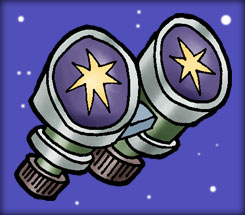Go to the Dark Side and Explore The Night Sky
- December 5, 2013
- By Michael Kline
 A few years ago I took my two sons on a fossil-finding expedition through the Badlands area of South Dakota. What we found mostly was the Dakotans penchant for roadside signs pitching reptile farms, the Corn Palace, and Wall Drug (whatever that was). We managed to escape with some interesting examples of small nautiloids, which I later learned was illegal (sorry National Park Service), but the most wonderful thing we found was not on the ground.
A few years ago I took my two sons on a fossil-finding expedition through the Badlands area of South Dakota. What we found mostly was the Dakotans penchant for roadside signs pitching reptile farms, the Corn Palace, and Wall Drug (whatever that was). We managed to escape with some interesting examples of small nautiloids, which I later learned was illegal (sorry National Park Service), but the most wonderful thing we found was not on the ground.
Because no “guy” vacation is complete without pitching a tent, we made our way to a very remote campground where we established Dino Base 1. After the requisite meal of beans and weenies, we settled in for the night. Somewhere around 3am the next morning, I felt the call of the wild porcelain convenience, and exited our tent in search of the closest Jonny-On-The-Spot. It was not difficult to find in all the darkness, but not until my trip back to the tent did I understand why.
I could see other cars, tents, and camping equipment, thinking that there must have been a full moon. But when I looked up, there was no moon in sight. I was navigating purely by starlight. And it was a sight I’d never seen before.
The sky was absolutely covered with stars. I want say “millions of them,” but the actual number of stars we can see ranges from 5,000 to 25,000, depending upon whom you talk to. What I really found interesting was that not all of those objects were stars. Some were complete galaxies (akin to our own Milky Way, which was in magnificent splendor that evening), each with its own set of millions of stars. Suddenly, I felt very small. “Hey kids! Wake up! You have to see this.” No response.
Sleepy children aside, there is a lot of talk these days about light pollution and how it no longer allows us to see the sky in the way our ancestors once did. Different types of migrating animals and birds are also confused by the artificial “daytime” that we humans have constructed to combat the darkness.
In 2001 Flagstaff, Arizona was named the world’s first “International Dark Sky City,” due to its efforts to properly use and maintain outdoor lighting in an effort to preserve the nighttime sky. To find more cities that are dark-friendly, visit the International Dark Sky Association.
But you don’t have to travel to Arizona to really see the night sky. Pack the kids in the car, preferably on a moonless, cloudless night, and head out of town for a side road somewhere (to avoid car headlights and streetlights of any kind). It’s better if the weather is a little chilly as colder air holds less moisture, which can cause any light to bounce around considerably. Bring some lawn chairs, and sit back and watch the show. I guarantee you will be amazed at what you will see.
There are also several apps for smart phones that let you “look” into the amazing number of constellations that will be in view, in addition to planets (yes, you can actually see Mercury, Venus, Mars, Jupiter and Saturn without a telescope) as well as the occasional satellite, known for zooming through the night sky. I personally use The Night Sky app by iCandiApps, but there are many available at low or no cost.
If you choose to go the historical route, explain to your kids how the nursery rhyme Hey Diddle, Diddle relates to several constellations and their positions relative to each other:
Cat = Leo (the Lion)
Fiddle = Lyra (the Lyre)
Cow = Taurus (the Bull)
Little Dog = Canis Minor (the Lesser Dog)
Dish = Crater (Apollo’s Bowl/Chalice)
Spoon = Ursa Major (the Plough/Big Dipper which looks like a large spoon/ladle)
From the website treasuryislands.wordpess.com comes a simple explanation:
“There are, apparently, certain nights (often in April) when a number of constellations seem close to the moon:Leo (the cat);Taurus (the cow);Canis Minor (the little dog);Crater (the dish),Ursa Major (the spoon) and Lyra (the fiddle). This theory supposes the rhyme to be a reminder to farmers and small holders to plant crops and sow seeds when they see the constellations close to the moon.”
So take some time with your children to explore the night sky a little closer. If driving many miles at night isn’t your thing, just go to an interior room of the house, shut off all the lights, close the drapes, and wait with the kids until you can make out most every feature in the room. It shouldn’t take more than about 5 minutes for your eyes to become totally adjusted to the dark. Challenge your children to be the first to spot something in the darkened area.
It’s a good exercise for being able to find your way to the bathroom at night too! Trust me. 🙂
Teach. Learn. Enjoy!


